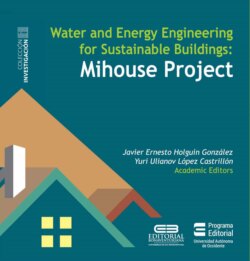Читать книгу Water and Energy Engineering for Sustainable Buildings Mihouse Project - Varios autores - Страница 10
List of Tables
ОглавлениеTable 2.1. Type A apartment data
Table 2.2. Values of the necessary variables for the calculation of the catchment area, water demand and water supply
Table 2.3. Calculation of maximum flow that transports the gutters in the apartment
Table 2.4. Maximum permissible flows in downspouts
Table 2.5. Number of required drainpipes
Table 2.6. Results of the monthly average precipitation, monthly water demand and water supply, and calculation of the demand and accumulated supply and storage volume
Table 2.7. Greywater consumption
Table 2.8. Devices that generate greywater at home.
Table 2.9. Apartments Distribution by type
Table 2.10. Storage volume for the Drinking water tank
Table 2.11. Drinking Water Pre-dimensioning
Table 2.12. Activities related to the water consumption
Table 2.13. Daily Cycles
Table 2.14. Total generated volume of water
Table 3.1. One-year time series detailed analysis of Mihouse electrical load
Table 3.2. Monthly Averaged Insolation Incident on a Horizontal Surface (kWh/m2/day)
Table 3.3. Top manufacturers
Table 3.4. Available surfaces
Table 3.5. Estimation of area per living unit module
Table 3.6. Energy load requirements per living unit
Table 3.7. Energy consumption during a regular day
Table 3.8. Annual Production
Table 3.9. Electric and Photovoltaic – special chart
Table 3.10. Characterization of total energy consumption in the competition’s house
Table 4.1. Comparative table of lightweight concrete and structural concrete
Table 4.2. Different properties between conventional lightweight concrete
Table 4.3. Comparison of Consumption Among incandescent lighting and LED lighting
Table 5.1. Estimation of the amount of waste generated in the residential condo
Table 5.2. Cost savings Mihouse complex, using the rainwater and groundwater exploitation system
Table 5.3. Mihouse project viability on saving resources
Table 5.4. Savings in pesos of Housing and Urbanization
Table 5.5. Waste quantity generated by the residential unit
Table 5.6. Quantity and valorization of waste to be exploited
Table 5.7. Calculation of the ecological footprint generated in the construction phase
Table 5.8. Calculation of the ecological footprint generated by transporting supplies and raw materials
Table 5.9. Calculation of the ecological footprint generated by transporting construction waste
Table 5.10. Calculation of the ecological footprint generated using the prototype
Table 5.11. Calculation of the ecological footprint generated by the use of the demolition of prototype
Table 5.12. Calculation of the ecological footprint of building materials associated with the life cycle analysis
Table 5.13. CO2 Emission FACTOR per kWh
Table 5.14. Emission per Technology
